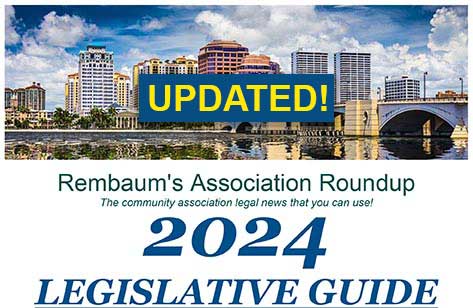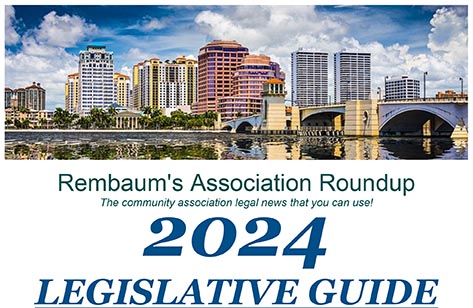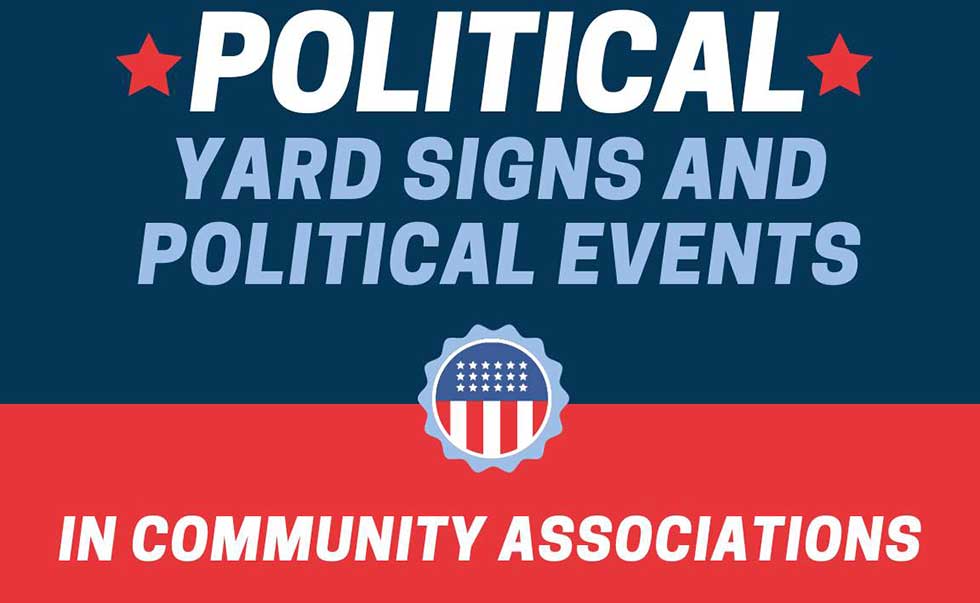The Complete 2024 Legislation Guide Affecting Florida's Community Associations
Now available for Download. Click HERE TO DOWNLOAD.
The 2024 legislative bills affecting Florida’s community associations are in play and if not already signed into law, are expected to become law; The Bills at issue are:
- HB 1203, affects homeowners’ associations (signed by the governor and effective July 1, 2024)
- HB 59, affects homeowners’ associations (signed by the governor and effective as of July 1, 2024)
- HB 293, affects homeowners’ associations (signed by the governor and effective immediately)
- HB 1029, affects condominium associations (signed by the governor and effective as of July 1, 2024)
- HB 1021, affects condominium associations (expected to become law, effective July, 1, 2024, but as of writing this article, not signed by the governor).
- SB 382, affects managers CEU requirements (signed by the governor and effective as of July 1, 2024)
- And of course, no 2024 Legislative Guide would be complete without a discussion regarding the Federal Corporate Transparency Act requirements, which we also include.
Anyone who would like a copy of our complete 2024 Legislative Guide can download it by clicking HERE.
The following information is not intended to replace our 2024 Legislative Guide but rather is intended to address only a few of the more interesting upcoming changes.
HB 1203 (affecting HOAs) and HB 1021 (affecting condominiums) both provide for new community association manager requirements as amended in Chapter 468, Florida Statutes, including such items as posting of the manager’s duties and available hours of the manager, along with a plethora of new financial interest disclosures which if not strictly adhered to can lead to possible cancellation of the management contract. In the outline provided on our website as referred to above, all of these new requirements are together in one place (which, in our view, is how the legislature should have presented these new requirements).
A few of the new provisions affecting homeowners’ associations, follow:
- An HOA with 100 or more parcels must have a website, and the new law provides for which documents must be posted on that website
- Membership meeting posting requirements now include the necessity that any document to be considered by the members by way of a vote must also be posted
- The HOA must adopt written rules governing the method by which official records are to be retained and periods that such records must be retained. The law clarifies that most official records must be retained for at least seven years
- Owners have the right to request a financial accounting, which must be provided within 15 business days of the written request, and failure to provide it can lead to the extinguishment of a fine
- It appears all board members must be certified by taking a four-hour class, and such certifications remain valid for only four years. In addition, if there are fewer than 2500 parcels, then the HOA board members must complete four hours of continuing education annually, and if greater than 2500 parcels the HOA board members must complete eight hours of continuing education annually
- New criminal penalties are associated with forging of a ballot envelope or voting certificate along with refusal to allow inspection or copying of official records in furtherance of any crime
- Before October 1, 2024, all HOAs must provide a physical or digital copy of the association’s covenants and rules to every member of the association
- All HOAs must adopt hurricane protection specifications for each structure or other improvement on a parcel governed by the association.
Regarding whether the following legislative changes will apply to existing HOAs will have to be determined later, but suffice it to say, it is this author’s opinion that new laws affecting existing substantive contract rights cannot be applied retroactively, absent Kaufman language in the declaration) because to do so impairs such existing substantive contract rights. in other words, there are constitutional protections against governmental impairment in existing contracts. Therefore, absent clear intent expressed within a governing document for changes in the law to be effective against various covenants, it is unlikely that this type of legislation can be applied retrospectively, but only time will tell.
- The HOA, including its architectural committees, may not enforce or adopt a covenant rule or guideline that limits or places requirements on the interior of a structure that is not visible from the parcel’s frontage or adjacent parcel or adjacent common area or community golf course
- Similarly, the HOA cannot require a review and approval of plans regarding central air conditioning, refrigeration, heating, or a ventilating system if such a system is not visible from the parcel’s frontage, an adjacent parcel, an adjacent common area, or community golf course and is similar to a system that is approved or recommended by the association
- Regardless of any covenant restriction, bylaw, or rule, the HOA may not restrict parcel owners from installing, displaying, or storing any items on a parcel which are not visible from the parcel’s frontage, adjacent parcel, adjacent common area, or community golf course including but not limited to artificial turf, boats, flags, vegetable gardens, clothes lines, and recreational vehicles
- Pickup trucks cannot be prohibited from being parked in the owner’s driveway or any other area where the owner or their guest or invitee has the right to park
- Work vehicles regardless of any insignia or visible designation on the vehicle cannot be prohibited from being parked anywhere the owner, guest, or invitee may park, so long as it is not a “commercial motor vehicle” as defined in the Florida Statutes
- Contractors may not be prohibited from entering the community solely because the contractor is not on a preferred vendor list
- Homeowners’ association documents may not preclude a property owner from hiring a contractor solely because the contractor does not have a professional or occupational license
- The HOA may not require a contractor or worker to present an occupational license to be allowed entry into the HOA.
As to condominium associations, and already passed into law:
- The “My Safe Florida Condominium Pilot Program” is created in Chapter 215, Florida Statutes, and provides procedures to apply for inspections and grants for certain mitigation projects. There are requirements for both board and membership approval to apply for the grants. The DBPR must promulgate grant forms and such prior to the program being in a position to provide any funding. Grants must be matched on the basis of one dollar provided by the association for every two dollars provided by the state. The association may receive grant funds for both roof-related and opening protection-related projects, but the maximum total grant award may not exceed $175,000 per association. Once the money allocated to the grant program, which we understand is a total of $30 million, runs out, the money is gone. This means that if each condominium association receives the maximum amount, only 171 condominium associations will benefit.
If passed into law, here are a few of the new laws affecting condominium associations:
- Board members must be certified by taking a board certification class that is at least four hours long and provides instruction on a variety of required subjects. The certification is valid for seven years so long as a board member serves without interruption. Each condominium association board member is required to take one hour of continuing education per year. Board members elected or appointed before July 1, 2024, must comply with the new written certification and educational certificate requirements by June 30, 2025
- An additional exception from the milestone requirements is provided for family dwellings with three or fewer habitable stories above ground
- Official records must be maintained in an organized manner that facilitates inspections of the records by a unit owner
- The association may fulfill its obligations by providing official records to requesting members by directing such a member to the association website
- In response to an official records request, a checklist of all records made available must be provided to the requesting member as well as identification of those records which were not made available
- When posting a board meeting agenda, if there is an item relating to the approval of a contract for goods or services, then a copy of the contract must be provided with the meeting notice
- A residential condominium with more than 10 units must have a board meeting at least once each quarter where the agenda includes an opportunity for members to ask questions of the board. Such right of the members includes the right to ask questions related to reports on the status of construction or repair projects, status of revenues and expenditures, and other issues affecting the condominium
- At least 90 days before an election, any member whose voting rights are going to be suspended must be provided notice that their voting rates are going to be suspended due to nonpayment of a fee or other monetary obligation
- The term “hurricane shutter” in Chapter 718 is now replaced with the term “hurricane protection.” All condominium associations are required to adopt hurricane protection specifications
- The Statute of Repose (i.e., the absolute last date a builder/construction professional can be sued) now begins to run at the turnover of the association from the developer to the unit owners rather than from the date of the temporary certificate of occupancy. This is an extremely important change to protect the rights of the unit owners to be able to bring construction defects lawsuits when necessary under the circumstances
- It is unlawful for the association to engage in retaliatory conduct against a unit owner who, in good faith, complained to a governmental agency, filed a complaint against the association, alleged violations of chapter 718, or made public statements critical of the operation or management of the association, etc. This is an expansion of the prohibition against “SLAPP” lawsuits (i.e., “strategic lawsuits against public participation”).
As you have already read, this year’s proposed legislation is extensive. For a more detailed analysis please CLICK HERE to download your comprehensive digest of these new laws.
While I would prefer each reader download his/her/their own version, nevertheless you are most welcome to download the 2024 Legislative Guide and share it with your fellow board members, managers, and community members so long as our cover page and all material remain intact. If you would like to reprint the 2024 Legislative Guide in your own email blast, please contact me for permission at:
JRembaum@KBRLegal.com.
(Written by Jeffrey Rembaum (Kaye Bender Rebaum) and reprinted with permission from the “Florida Community Association Journal“.)












